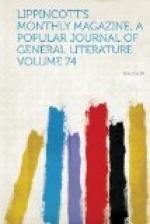whether of those who have been at Rome or not, knows
the Temple of Vesta, for it is the prettiest, if not
the grandest, of the legacies to us of old pagan Rome,
and it has been reproduced in little drawing-room
models by the thousand in every conceivable material.
Close to it, at one corner of the piazza, is the ancient
and half-ruinous house which is pointed out as the
habitation of Cola di Rienzi. It is altogether
a strange-looking spot, that Piazza della Bocca della
Verita, standing as it does on the confines of what
may be called the inhabited part of Rome and that
portion of the huge space within the walls which still
remains sacred to the past and its memories and remains.
But not the least strange thing about it is its name—the
Piazza of the Mouth of Truth! There is
a story of some one of the great doctors of the early
ages of Christianity having taught in the very ancient
church which stands on the side of the piazza farthest
from the Tiber. Ay, to be sure, the name must
come very evidently thence. The “mouth
of truth” was the mouth of that seraphic or
angelic or golden-tongued or other “doctor gentium,”
and the old church and the piazza still preserve the
memory of his eloquence. Not a bit of it!
Under the venerable-looking portico of this church
there is a huge colossal marble mask, with a gaping
mouth in the middle of it. There it lies, totally
unconnected in any way with the various other relics
of the past around it—tombs and frescoes
and mosaics—and the stranger wonders what
it is, and how it came there. To the last question
there is no reply. But in answer to the former,
tradition says that the Roman populace when affirming
anything on oath were wont to place their hands in
the mouth of this mask as a form of swearing, and
hence the stone was called the “Bocca della Verita,”
and has given its name to the piazza.
Well, it was while traversing this piazza a few days
since with a stranger friend, whom I was taking to
visit the curious old church above mentioned, that
I received and returned the salutation of an acquaintance
whose appearance induced my companion to ask with some
little surprise who my friend was. The individual
whose courteous salutation had provoked the question
was a horseman mounted on a remarkably fine black
mare. Whether, in consequence of some little
touch with the spur, or whether merely from high condition
and high spirits, the animal was curvetting and rearing
and dancing about a little as she crossed the piazza,
and the perfect ease—and one may say, indeed,
elegance—of the rider’s seat, and
his consummate mastery of the animal he bestrode,
must have attracted the attention and excited the
admiration of any lover of horses and horsemanship.
It was abundantly evident that he was neither one
of the “gentlemen riders” who figure in
the somewhat mild Roman steeple-chase races, nor of
those Nimrods from beyond the Alps who, mounted on
such steeds as Jarrett or Rannucci can supply them




